[ Special Hobby ]
1/72 scale model of the FMA Pucara from Special Hobby
page 2
Argentina's air force requested in the 1960s the Argentinian factory FMA to make a proposal for a light COIN aircraft. The FMA design got two crew members in tandem sitting under a large canopy and two turboprop engines with a high landing gear enabling also the deployment from simple rough air strips. The program started in 1967 but production of the Pucara not earlier than in 1974. It eventually got the Turbomeca Astazou engines, 2x 20mm canons and 4x 7.62mm machine guns in the nose and various pylons could be fitted to drop various smaller bombs. Due to economic crises in Argentina, the production rate was low and during some 10 years some 108 IA.58A Pucara's were manufactured.
Pucara's were also used in the Falkland War after these aircraft were quickly painted in camouflage paints and sent to the islands. Pucara's performed several strike missions against the British Forces.
FMA Pucara's were also exported e.g. to Colombia, Uruguay and Sri Lanka and many still serve with the Argentina Air Force.
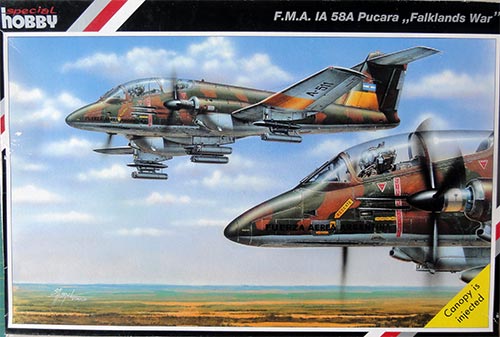
Special Hobby released an injection moulded kit in 2003. Kit #SH72047 has some 50 parts including resin parts for the seat, nacelle intakes and exhausts, antennas and an etched fret for instruments, seat harnasses and landing gear details. A small photo negative is also supplied for the instruments. The kit is short run but is of good quality and the panel lines are finely engraved.
(The same kit was released in 2008 by Airfix in box #A03068 but the resin parts were substituted by plastic parts in an additional sprue and it included RAF markings of a captured Pucara test flown in the U.K.).
The Special Hobby kit will be made as an Argentine Pucara during the Falklands War.
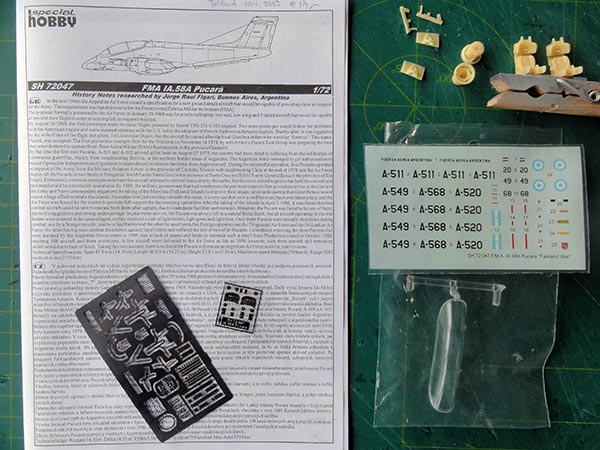
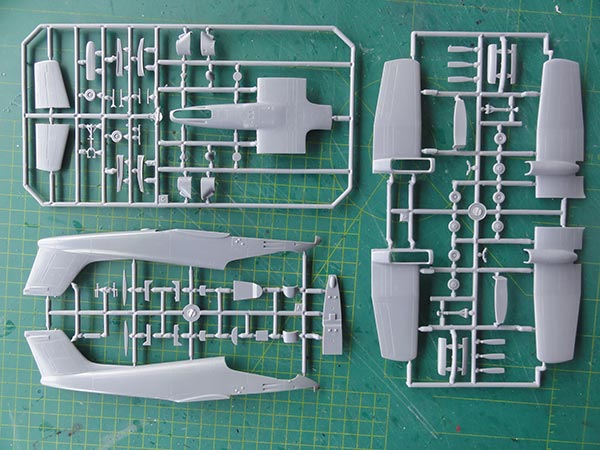
Kit decals are for 2 Argentine Pucara's in an aluminium scheme and 2 in a camouflage scheme with a choice in aircraft numbers.
This kit was also released later on by Airfix, see page 2.
Now how accurate is the kit?
I saw an article in the past of Jorge from IPMS Argentina who had investigated the kit and a real Pucara in a local museum.
(1) The kink at the dorsal fillet in front of the vertical tail is not very prominent in the kit. This can be corrected with some sawing, card and sanding. It improves a lot how the model will look.
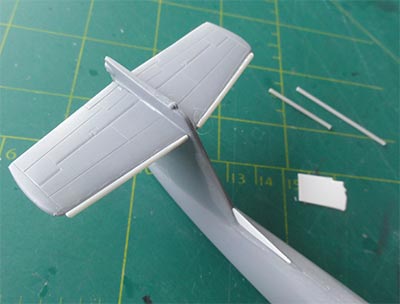
(2) It appears that the leading edge sweep of the horizontal stabilizer is 5 degrees too large. This I corrected with some card and putty and it is visible.
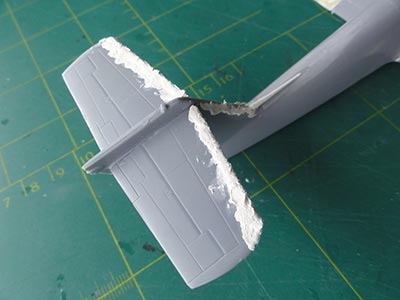
(3) The lower fuselage belly at the wing is a bit too flat; I could not see the real defect in photos as it is hidden by the nacelles, so it was left as per kit. And the belly is hidden in 99% of cases with a central pylon is seen fitted on the Pucara, often with a bomb rack. This will be made and added.
(4) immediately in front of the ailerons on the upper wing 2x24 vortex generators are seen on a real Pucara. These are missing on the model. I decided to add all these with small bits of sprue.
Building the kit
I also drilled open the small gun and canon recesses in the nose.
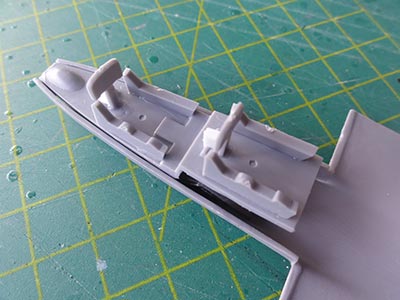
The rest of the kit assembly was done as per instructions. Before closing the nose, it is important to add a LOT OF weight to avoid a tail sitter.
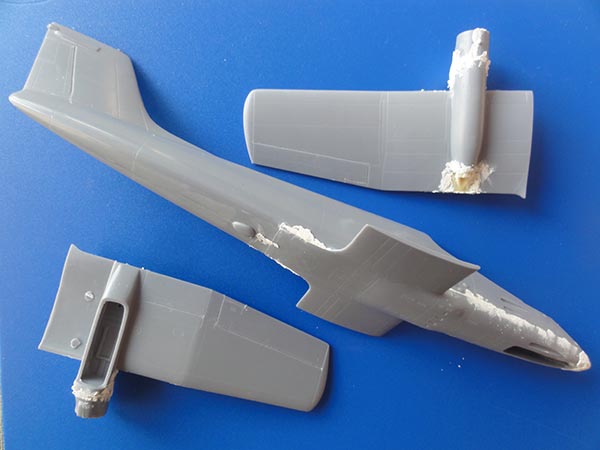
Some sanding is needed and some putty particularly at the lower nose section with the separate insert and the nacelles. Also a bit work is needed to get a smooth exhaust pipe assembly.
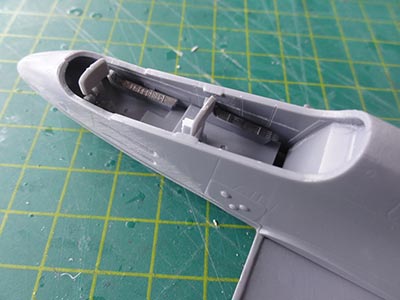
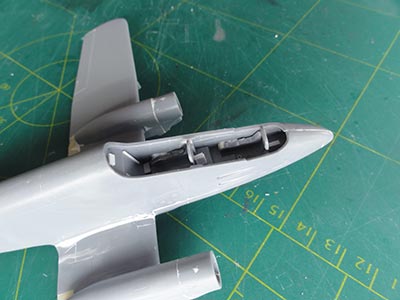
Also note that the nacelles are similar port and starboard so smaller bits and vents are not "mirrored". I added a few hydraulic lines made from thin metal wire in the gear bays.
The 2x24 vortex generators were added from thin sprue in front of the ailerons. Making these from card is undoable, so sprue was used in stead.
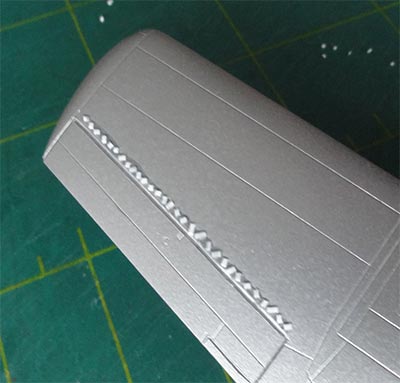
After assembly, a couple of light grey base coats of Revell Aqua #75 steingrau were applied with the airbrush to check for any flaws that needed rework.
Colours and scheme
A camouflaged Pucara was to be made as model. Now what are the colours?
I studied various books and magazines and the internet. The colours vary a lot. First, Pucara's were quickly hand painted with camouflage and second photo quality in those hectic times varied. I found some photos of the same Pucara "A-536" and this was picked.
The colours used were:
- overall model first aluminium airbrushing Revell Aqua 99 acrylic; (some were very light blue but most Pucara's flew on the main land in overal metal/ aluminium);
- next on the upper and side surfaces an airbrushed coat of Gunze Sangyo 50 Lime Green acrylic;

- next after masking the upper pattern a coat of Revell Aqua 16 Sand.
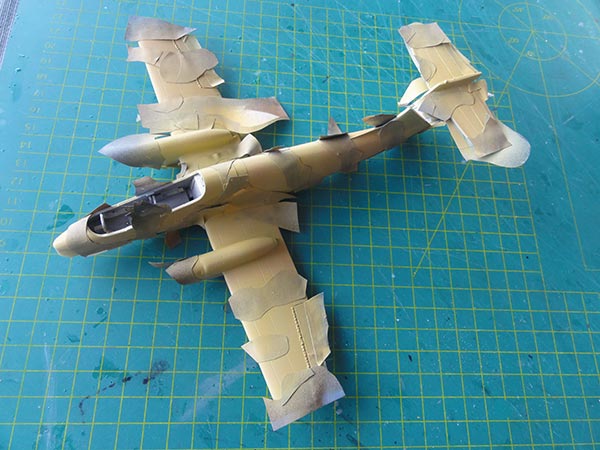
I used the kit decals and spare decals but to avoid "silvering" the model got first some coats applied with the airbrush of Johnson Future/Pledge varnish.
Decalling was done.

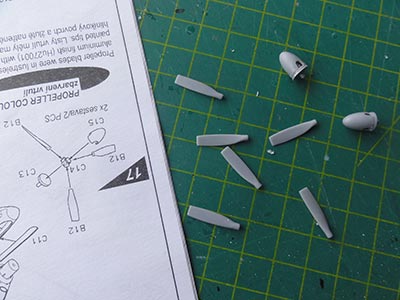
The 2 propellers need care as it are all separate parts: 2x3 blades are to be fitted on 2 tiny central hubs. (alternatively you could try to find an Aeroclub metal prop set).
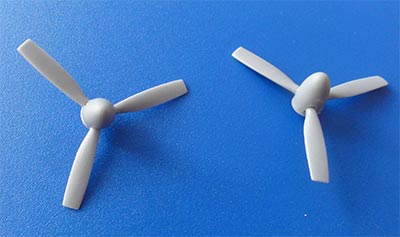
The propeller base coat is aluminium with black anti-icing boots and yellow tips. The nacelle fronts are polished metal and the prop shaft also shows a blue band. This was all hand painted.

Next details like the undercarriage were set on the model. Each wheel has 2 halves and needs some work to get a smooth result. I drilled a hole in each wheel to fit it on the gear leg. The gear legs I painted aluminium with also aluminium wheel hubs.
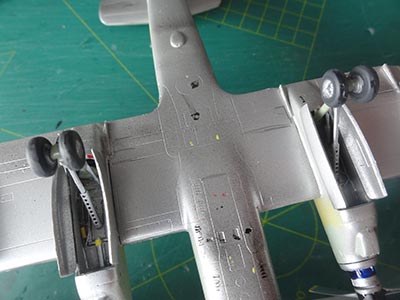
I added from thin metal wire some hydraulic lines in addition to the etched fret kit detail parts.
The cockpit tub and interior I painted medium grey. The nice resin MB mk.8006 seats were added after being painted dark grey and green cushions and the etched metal harnasses added. On each seat head rest a thin activation yellow-black striped cord was added.
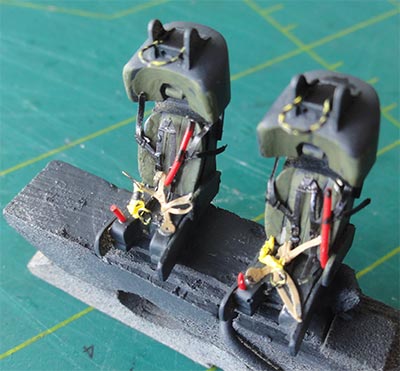
Anti-collision lights were painted on the wing tips. I also made from card a central pylon and added a bomb rack found in a Hasegawa weapons set.
Overall a semi-matt transparent coat was airbrushed onto the model (using Johnson Future/Pledge varnish with 20% Tamiya X-21 Flat base mixed in).

An long wire antenna runs from the spine to the tail and this was added with flexible black EZ-line.
I wanted to set the canopy open to show the nice details in the cockpit. It is one piece so with a lot of care with a very fine TIGER razor saw it was cut in two.
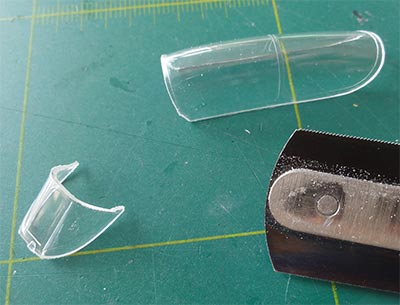
The canopy and windscreen frames were painted aluminium and 2 mirrors were installed from 2 tiny scrap metal bits. The canopy was set onto the model and the Pucara was ready!
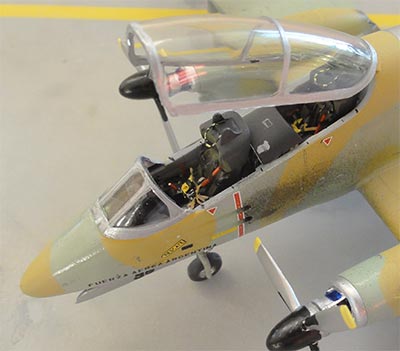
ARGENTINA
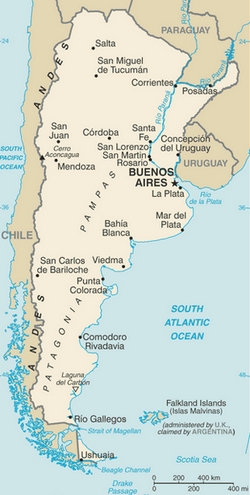



[ area: 2,780,400 sq.km | population: 47,3 million | capital: Buenos Aires | GDP USD 10,000 per capita nominal ]
Argentina is the second largest country in South America. A military aviation school was set up in 1912 with French biplanes at El Palomar. Following the First World War, an Italian support mission arrived with Ansaldo fighters, Caproni bombers and in 1920 additional French aircraft arrived. A small aircraft factory was set up a Cordoba from 1927 to produce under license foreign aircraft. They started with license production of Wright Cyclone engines and Curtiss warplanes. In the thirties the Government supported aviation including owned aircraft for civilian flying clubs. The air force now had Dewoitine D.21 and Curtiss P-36 Hawks and types like Martin B10 bombers. At the end of the Second World War modernization began of the "Fuerza Aerea Argentina" with Fiat G.55 fighters, Avro Lancasters and Lincolns and C-47 and C-54 transports. In the late 1950s also Paris trainers and Beech Mentors were license manufactured. After the Second World War Argentina under Peron rule and Paraguay under Stroessner rule was a hide out of nazi fugitives, particularly Argentina's Bariloche region. In the fifties some aircraft were designed and manufactured by FMA in Cordoba with German assistance like the Pulquin and later followed by the manufactured IA.35 Huanquero. In the 1960s F-86 Sabres and Meteors arrived as well as Canberra bombers and Grumman Albatros amphibians.
Argentina also set up a rather large Naval Aviation force from 1920. From Britain in 1958 HMS Warrior was acquired second hand and Trackers and Corsairs began to fly from 1959 off this carrier that was now named the "Independencia". At the same time, the Aviacion Naval bought 28 second hand ex-USN F9F-2B Panthers.
The air force received several FMA aircraft like IA.50 Guarani's II and and FMA also produced the IA.58 Pucara attack aircraft with many aircraft delivered.
A military coup in 1976 took place with military dictatorship and a "Dirty War where many protesting civilians disappeared". France also supplied in 1981 and 1982 14 Dassault Super Etendards to the naval air service that could fire the Exocet anti-ship missile.
The conflict of the Falklands War emerged after Argentina declared that the "Islas Malvinas" e.g British Falkland Islands and South Georgia were now Argentinian "territory" and were occupied April 1982. Along with troops, some Pucara's and smaller aircraft were deployed to small air strips.
A furious British armed response followed and a large Royal Navy fleet was sent to the Falklands. The Royal Air Force carried out operation "Black Buck" with bombing missions at long distances of 15000 kilometers with Avro Vulcans requiring multiple in-flight refuelings. Argentinian aircraft operating from the mainland were Skyhawks and Mirages but the most notorious was the Super Etendard. Even the fact that Argentinians had only received 5 Exocet missiles, large losses were inflicted on ships of the British Royal Navy. The Falklands were liberated after 10 weeks and British again.
---
The Pucara's were quickly roughly painted in a camouflage scheme including Pucara "A-536". Pucara's performed several strike missions against the British Forces but the Pucara's were very vulnerable for ground fired missiles and Sea Harriers.
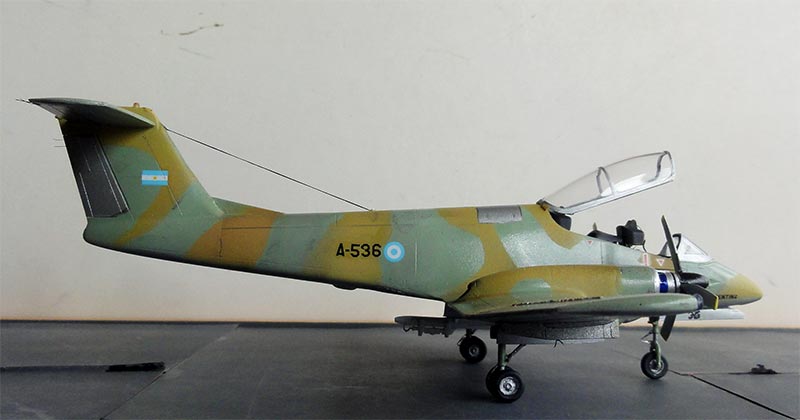

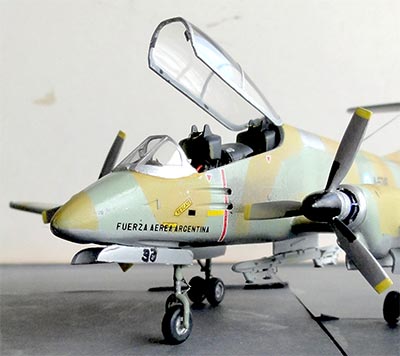
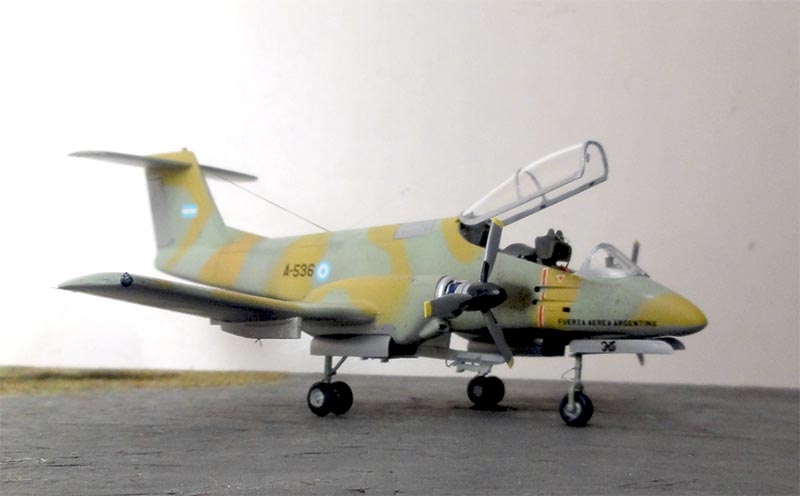
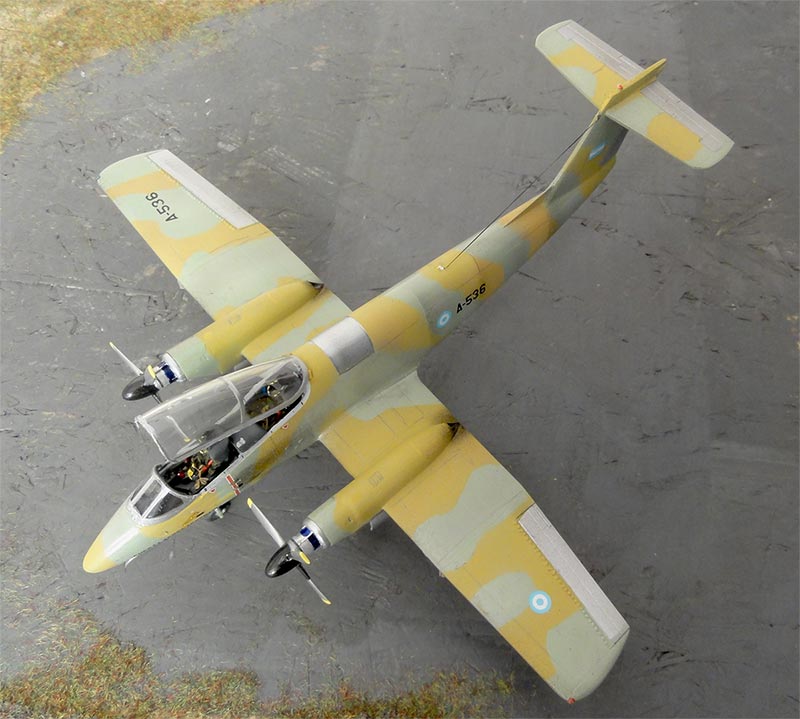
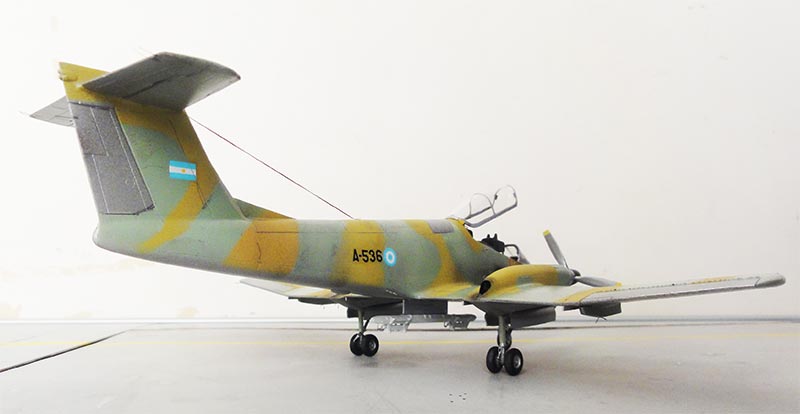
.. at the Falklands. Pucara "A-536" April 1982. Was damaged May 1982 during the war.
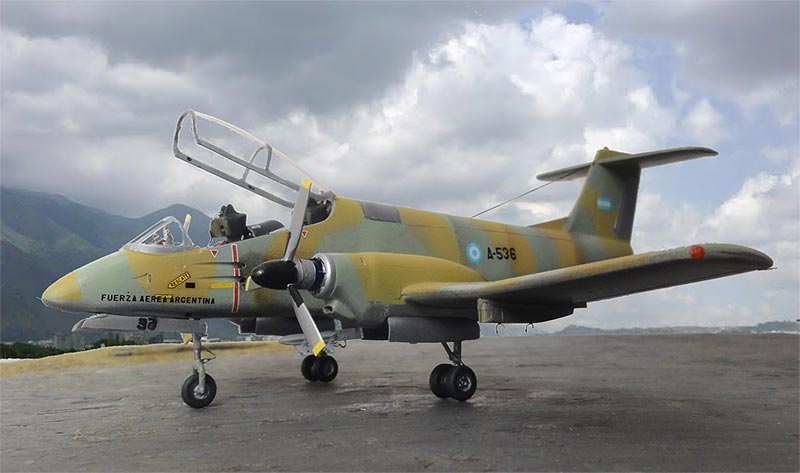
On to [ page 2... ]
- World Air Power Journal Volume 9, Summer 1991;
- Scale Aircraft Modelling magazine, Vol.36/ 04, June 2014
Back to 1/72 Models.......

(c) Copyright Meindert "designer"/ All rights reserved. Your comments are welcomed by webmaster
Created this page
June 25, 2018